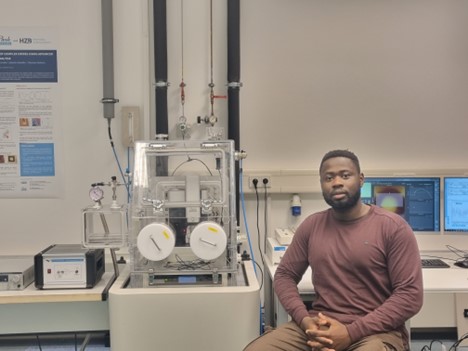
Israel Ibukun Olaniyan is a Ph.D. candidate at the Free University of Berlin and Helmholtz Zentrum Berlin in Professor Catherine Dubourdieu’s group. Prior to starting his Ph.D., with the aid of the Egbe Omo Oduduwa scholarship, he obtained a BSc degree at Obafemi Awolowo University (Ile-Ife, Nigeria), where he received the award of the best-graduating student from the department of Physics in 2012. His first Msc degree was also obtained at Obafemi Awolowo University, and after receiving the Korean government student scholarship (KGSP), he got another MSc degree in Applied Physics at Daegu University, South Korea, in 2019.
His present research focuses on “Ferroelectricity at the nanoscale on Silicon”.
1. Please summarize the research you do and explain why it is significant?
Nanostructures are significant for the fundamental study of ferroelectricity and the scaling of integration density. In my research, I grow perovskite thin films on silicon and pattern them in a helium ion microscope to form nanopillars of sub 500 nm in diameter. As it is a nanoscale structure, the electrical polarisation pattern can be more complex than in a thin film. I investigate the emerging polarisation pattern and how it can change with the size of the pillars. I characterize the nanopillars with piezo force microscopy and advanced synchrotron techniques.
2. How might your research be used?
From a technological point of view, the research has applications in nanoelectronics for non-volatile memory devices and electromechanical systems. From the theoretical point of view, the research can help further the knowledge about ferroelectric materials, such as the critical thickness of ferroelectric materials on silicon, and exploration of novel phenomena that can emerge due to reduced lateral size effect in ferroelectrics.
3. Why is the Park AFM important for your research?
The Park AFM is important for my research because:
1. The optics and calibrated motorized XY stage allow easy navigation of the fabricated nanostructures.
2. I can use the Park AFM to obtain topographic information on the fabricated nanostructures by using the AFM non-contact mode.
3. Writing and reading of ferroelectric domains can be carried out with Piezoresponse Force Microscopy (PFM) mode.
4. The switching spectroscopy PFM mode allows for the determination of the coercive field and magnitude of the piezoresponse in the nanostructures.
4. What features of Park AFM are the most beneficial and why?
The hardware and software are very user-friendly. It is easy to incorporate hardware for advanced modes with the Park AFM without complicated wirings.




